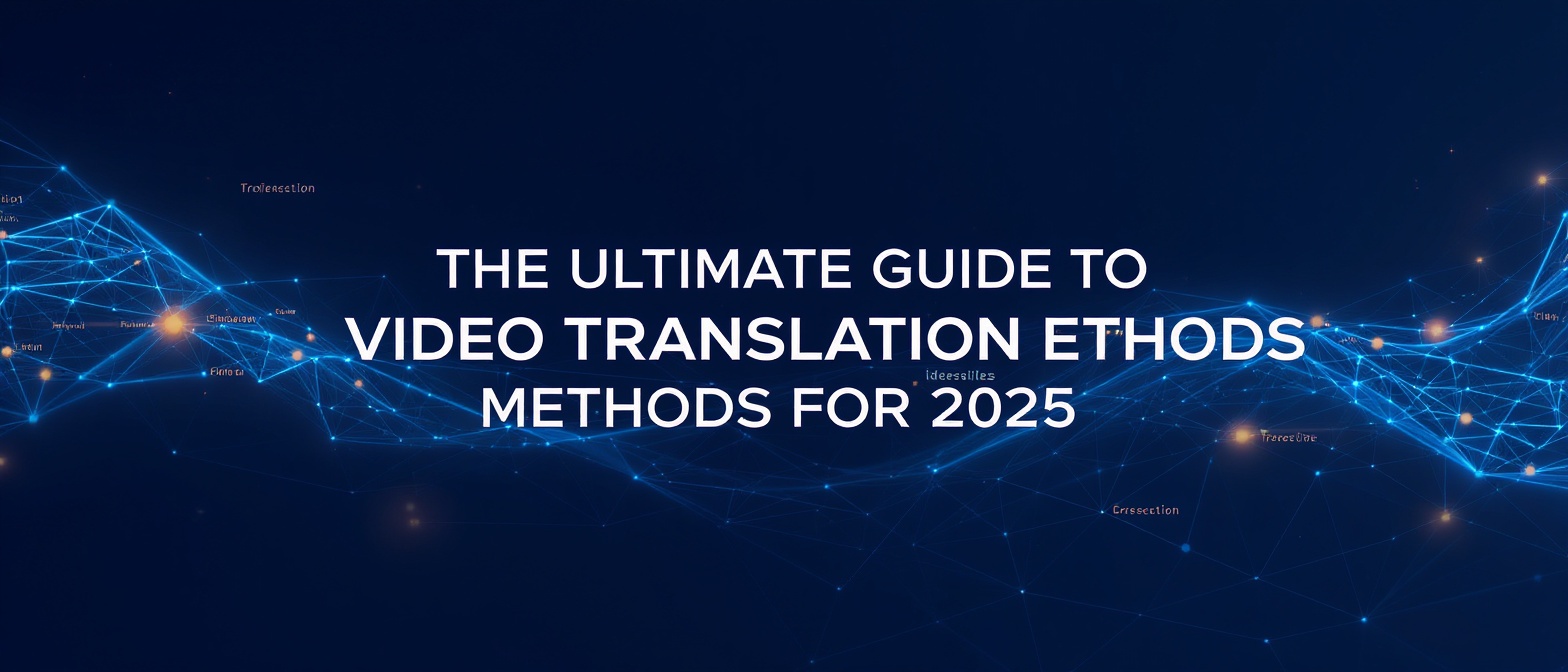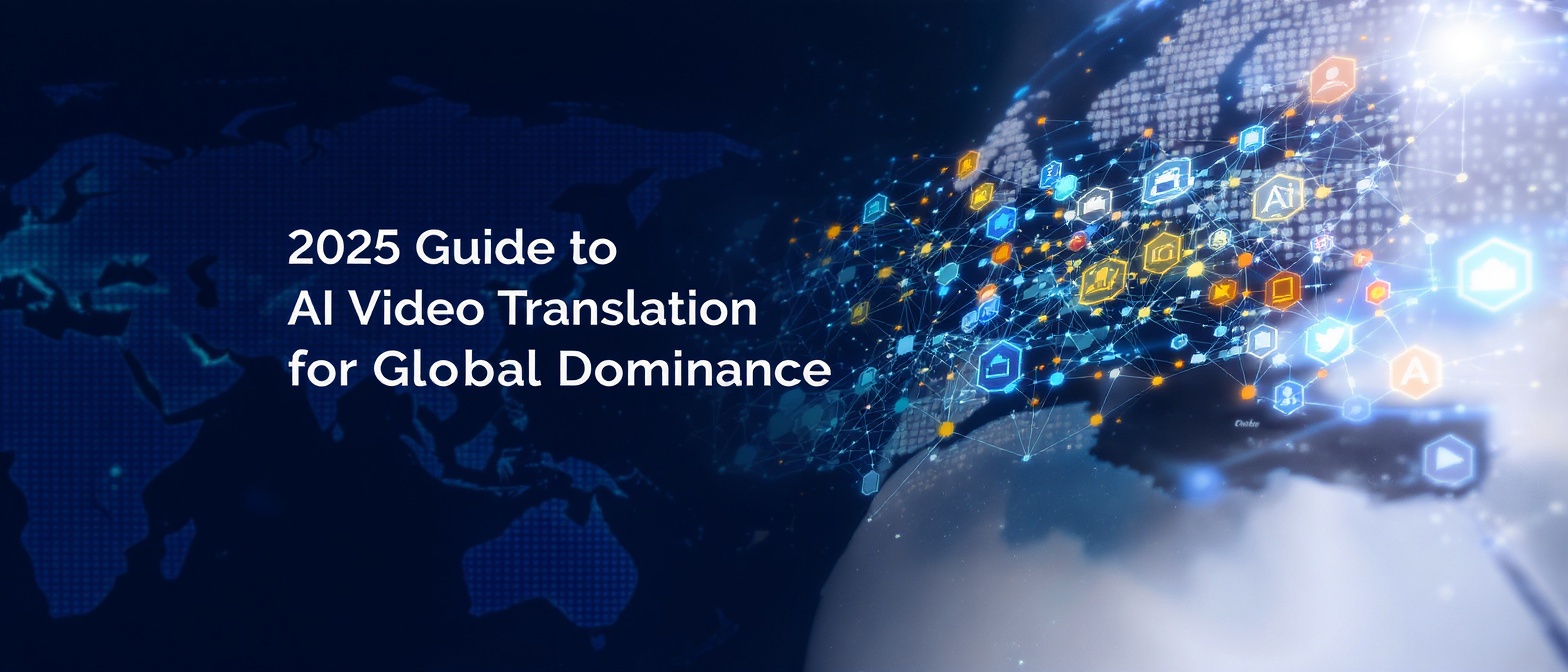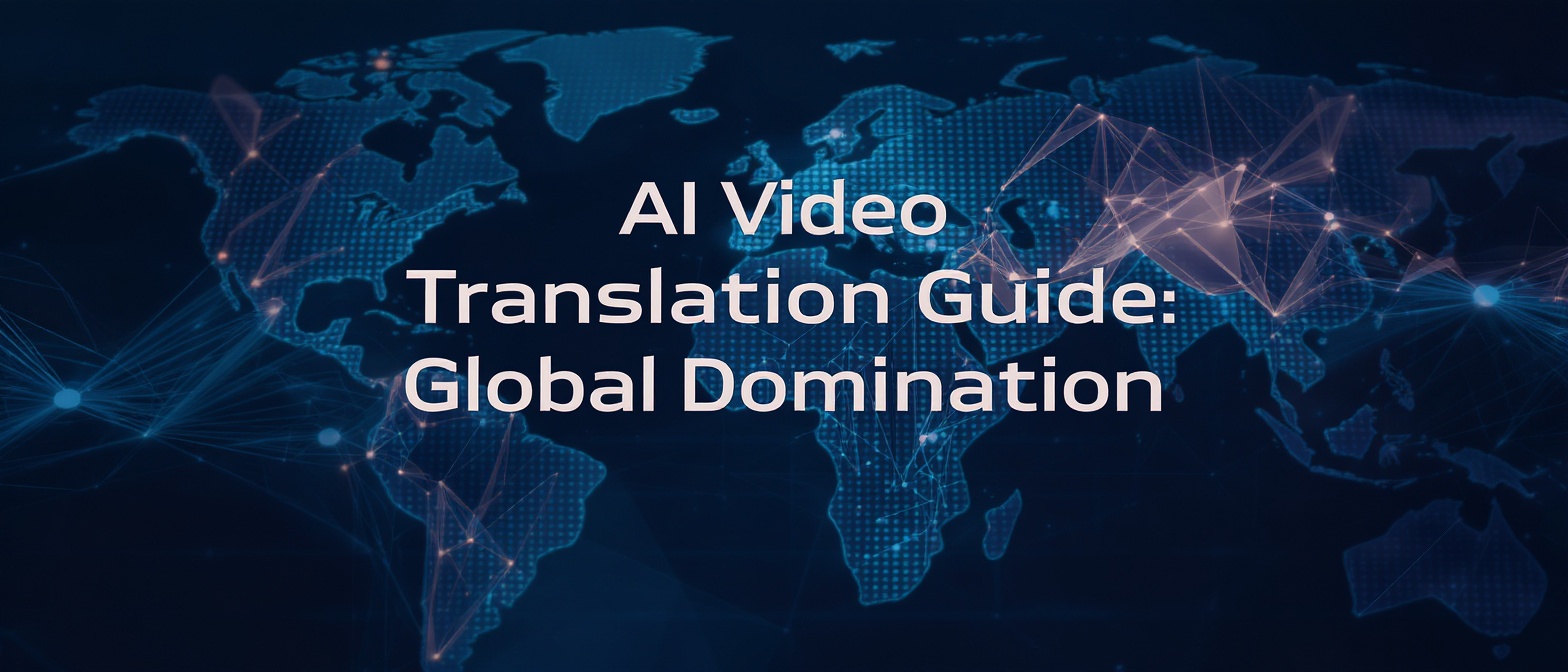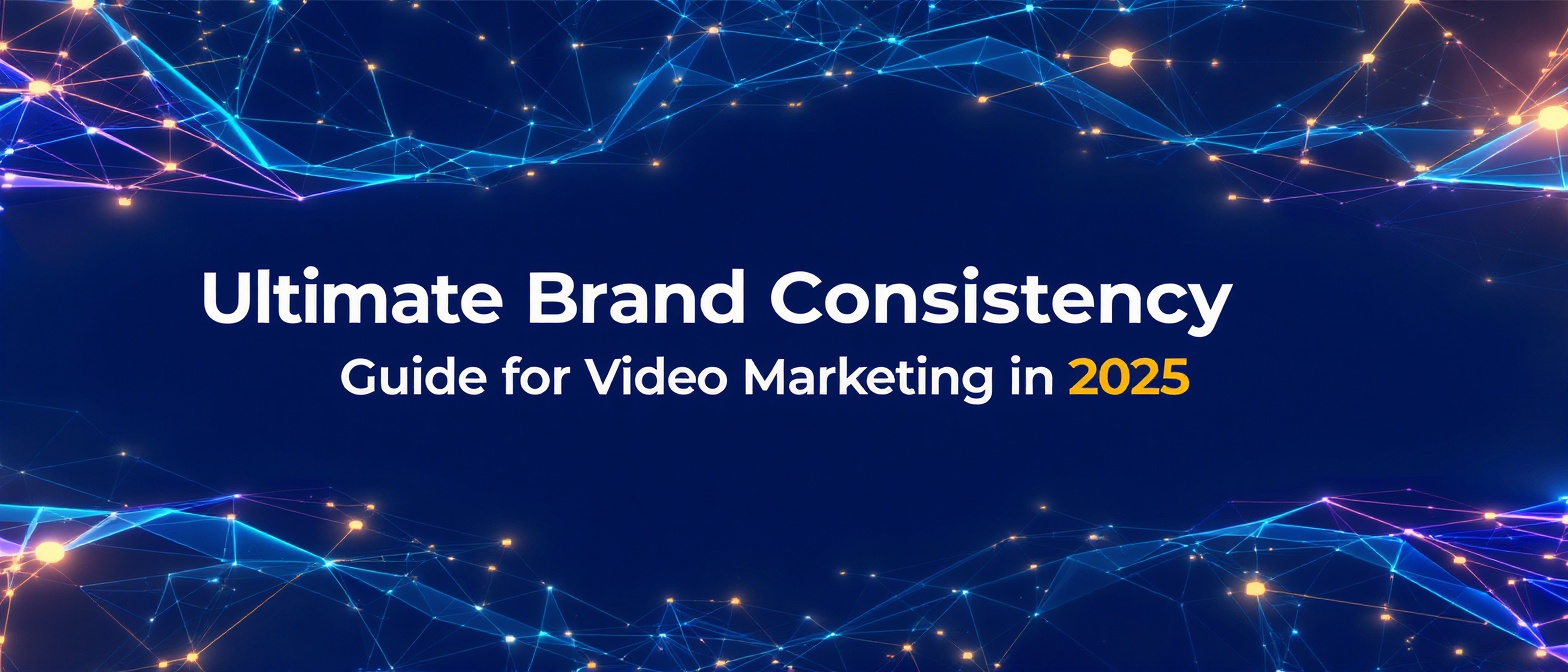The Ultimate Guide to Video Translation: 7 Methods to Maximize Your Global Reach in 2025
Estimated reading time: ~10 minutes
Key Takeaways
- Video translation is an essential growth strategy for 2025.
- AI-powered methods significantly reduce cost and time.
- Seven distinct techniques range from simple subtitles to advanced AI avatars.
- Cultural nuances and transcreation are crucial for authenticity.
- Tracking ROI and measuring performance ensure success.
In today's hyper-connected world, video isn't just a part of the internet; it is the internet. But if your video content only speaks one language, you're leaving a staggering amount of growth, engagement, and revenue on the table. The solution is clear: a robust strategy using modern video translation methods. As the global language services market is projected to skyrocket to $76.78 billion in 2025, businesses that fail to adapt will be drowned out by a rising tide of multilingual content.
This is no longer a luxury for multinational corporations. With the rise of AI-powered video translation, localizing your content for global audiences is more accessible, affordable, and effective than ever before. This comprehensive guide moves beyond a simple list of options. We will provide a strategic framework for translating your videos, exploring seven distinct methods, and showing you how to measure your success to achieve maximum global impact and a tangible return on investment.
Why Video Translation is a Non-Negotiable Growth Strategy for 2025
Before diving into the “how,” it’s critical to understand the “why.” Embracing video translation is not just about being inclusive; it’s a calculated business decision that directly impacts your bottom line, brand authority, and market penetration.
The Exploding Digital Market: Beyond English Speakers
While English has long dominated the internet, the digital landscape is rapidly diversifying. Over 75% of the world’s internet users are non-native English speakers. Furthermore, a 2020 CSA Research study revealed a powerful consumer insight: 76% of online shoppers prefer to buy products with information in their native language. By keeping your video content monolingual, you are effectively ignoring three-quarters of your potential market and creating a barrier to purchase for the majority of online consumers.
The Tangible ROI of Localization
Investing in localization is not an expense; it’s a high-yield investment. The AI in Language Translation Market is not just growing; it’s exploding, projected to reach $13.5 billion by 2033 with an impressive CAGR of 22.3%. This growth is fueled by proven results. Localized marketing campaigns don’t just perform better; they resonate on a cultural level, leading to:
- Higher Engagement Rates: Viewers are more likely to watch, like, comment on, and share content they fully understand.
- Increased Conversion Rates: From product descriptions to tutorials, clarity builds trust and drives sales.
- Improved Customer Loyalty: Speaking your customer’s language shows respect and a commitment to their experience.
Boosting E-E-A-T and Trust with Global Audiences
In the world of SEO and brand building, Google’s E-E-A-T (Experience, Expertise, Authoritativeness, and Trustworthiness) guidelines are paramount. Providing content in a user’s native language is a powerful signal of all four. It demonstrates your experience in their market, your expertise in communicating complex ideas clearly, your authoritativeness as a global brand, and builds immense trust by showing you’ve invested in their user experience. This can lead to better search rankings in local markets and a stronger overall brand reputation.
Pre-Translation Strategy: Setting Your Project Up for Success
Jumping straight into translation without a plan is like setting sail without a map. A few strategic steps beforehand can save you from costly revisions, cultural missteps, and ineffective campaigns.
1. Define Your Goals and KPIs: What does success look like? Are you aiming for increased brand awareness in a new market, higher conversion rates on a product page, or better engagement on your Japanese YouTube channel? Your goals will determine the best translation method. Key Performance Indicators (KPIs) could include view-through rate by region, click-through rate on localized calls-to-action, or lead generation from a translated webinar.
2. Understand Cultural Nuances vs. Literal Translation (Transcreation): The goal is not just to translate words but to convey meaning. This is the essence of transcreation. A phrase, joke, or cultural reference that works in one language might be confusing or even offensive in another. Research your target audience’s cultural norms, humor, and visual preferences. For example, colors, hand gestures, and even background music can have vastly different connotations across cultures.
3. Prepare Your Source Video: A well-prepared source file is the foundation of a great translation.
- Finalize the Script: Ensure your original script is clear, concise, and free of idioms that are difficult to translate. Provide a transcript with timestamps.
- Isolate On-Screen Text: If possible, export a version of your video with no on-screen text. This makes it much easier to replace with translated graphics.
- Pacing and Timing: Speak clearly and at a moderate pace. Leave brief pauses between sentences to accommodate languages that may be more verbose than the original, preventing the translated audio from sounding rushed.
The Core Methods: A Deep Dive into 7 Video Translation Techniques
With your strategy in place, it’s time to choose the right method for your project. These techniques range from traditional to cutting-edge, each with its own set of strengths.
Method 1: Subtitling (The Foundation)
Subtitles are text overlays that display the dialogue in a different language. This is the most common and often most cost-effective method.
- Pros: Highly affordable, preserves the original audio and speaker’s tone, improves accessibility for the hearing impaired, and can boost SEO as search engines can crawl the text.
- Cons: Can be distracting for viewers, may not capture the full emotional nuance of the spoken word, and is less effective for fast-paced dialogue or visually dense videos.
- Best For: Social media content (where many users watch with sound off), educational tutorials, interviews, and documentaries.
Method 2: Voice-over & Narration (Human-Powered)
This method involves recording a new audio track with a human voice actor who reads the translated script.
- Pros: Delivers a high-quality, emotionally resonant performance. Allows for nuanced localization of tone and style. It’s the gold standard for projects where emotional connection is key.
- Cons: The most expensive and time-consuming method. Requires casting voice actors, studio recording time, and audio mixing.
- Best For: Cinematic marketing campaigns, high-production brand films, e-learning courses, and content for children.
Method 3: Automated Transcription & Subtitle Generation
Leveraging AI to automatically transcribe the original audio is a massive time-saver. Once transcribed, this text can be fed into a machine translation engine to generate subtitles in multiple languages.
- Pros: Incredibly fast and scalable. Drastically reduces the manual effort of typing out a script. Many platforms offer this as a one-click feature.
- Cons: Machine-generated transcripts and translations require a round of human review to catch errors in grammar, context, and technical jargon.
- Best For: Large volumes of content, internal training videos, and as a first step in a hybrid workflow. You can find excellent guidance on creating and formatting subtitle files (like SRTs) from resources like the Mozilla Developer Network.
Method 4: Text-to-Speech (TTS) Voice-overs
TTS technology uses AI to convert a translated text script into a synthetic voice audio file. Modern TTS engines are remarkably natural-sounding, offering a variety of accents and tones.
- Pros: Far more affordable and faster than human voice-over. Allows for easy updates and corrections—simply edit the text and re-render the audio.
- Cons: Can sometimes lack the genuine emotional range of a human actor. The quality can vary between languages and platforms.
- Best For: Corporate announcements, news-style updates, and informational videos where straightforward delivery is prioritized over emotional performance.
Method 5: AI-Powered Dubbing & Lip-Sync (The Game-Changer)
This is where technology takes a monumental leap. AI dubbing doesn’t just replace the audio; it analyzes the original speaker’s voice, clones its characteristics, and then generates a new audio track in the target language that sounds like the original speaker. Advanced platforms even adjust the speaker’s lip movements to match the new dialogue.
- Pros: Unprecedented authenticity and viewer immersion. Maintains the original speaker’s vocal identity, creating a seamless experience. Massively scalable and fast.
- Cons: The technology is resource-intensive and is primarily available through specialized platforms.
- Best For: Influencer marketing, CEO addresses, sales training, and any content where the speaker’s personal brand and authenticity are crucial. Platforms like Studio by TrueFan AI enable creators and businesses to achieve highly accurate and natural-sounding dubbed content at a fraction of the cost and time of traditional methods.
Method 6: The Hybrid Model (AI Speed + Human Polish)
The most robust and increasingly popular approach combines the best of both worlds. It uses AI for the heavy lifting and human experts for the final quality assurance. A typical workflow:
- Use AI to transcribe the original video.
- Use machine translation to get a first-pass translation of the script.
- Have a professional human translator review and refine the script for cultural nuance and accuracy.
- Use an AI voice or dubbing tool to generate the new audio.
- A final human review of the complete video.
- Pros: Achieves near-perfect quality while being significantly faster and cheaper than a fully manual process.
- Cons: Requires coordination between technology platforms and human talent.
- Best For: Most business-critical projects, including major marketing campaigns, product demos, and customer-facing support videos.
Method 7: AI Avatar Presenters (The Future of Scalable Video)
Why translate a video when you can generate a new, native version from scratch in minutes? This revolutionary method uses a script and a photorealistic AI avatar to create video content directly in the target language.
- Pros: The ultimate in scalability. Create dozens of language variants of a marketing message in a single afternoon. Ensures perfect lip-sync and brand consistency. Eliminates the need for filming, studios, and actors.
- Cons: The content is generated, not a direct translation of a pre-existing human performance.
- Best For: Social media ads, personalized sales outreach, corporate training modules, and rapidly deploying campaigns across dozens of global markets. For ultimate scalability and brand consistency across markets, Studio by TrueFan AI’s 175+ language support and AI avatars allow companies to create unique video content from a script for any region, ensuring perfect lip-sync and a consistent brand presenter.
Measuring Success: How to Calculate the ROI of Your Translated Videos
Translating your videos is only half the battle. To prove its value and refine your strategy, you must track your performance.
- Key Metrics to Track: Go beyond simple view counts. Monitor engagement rate (likes, comments, shares) per language, audience retention graphs to see if viewers in certain regions drop off at specific points, and conversion rates on localized landing pages linked from your videos.
- Tools for Multilingual Analytics: Use tools like Google Analytics 4 to segment your audience by language and country. This allows you to directly compare how your Spanish-language video performs with your audience in Mexico versus Spain, for example.
- A/B Testing Your Translations: Don’t be afraid to test different versions. You can test different calls-to-action, different voice-over styles (e.g., male vs. female voice), or even different thumbnail images with localized text to see what resonates best with each audience. Solutions like Studio by TrueFan AI demonstrate ROI through dramatically reduced production costs, faster time-to-market for global campaigns, and the ability to test multiple language variants to optimize engagement.
Beyond Translation: Best Practices for a Global Video Strategy
A truly effective global strategy involves more than just language.
- Localize Visuals: Are the people, locations, and graphics in your video relatable to your target audience? Consider replacing B-roll footage or on-screen graphics to better reflect the local culture.
- Optimize for Multilingual SEO: Your localization efforts should extend to your video’s metadata. Translate your video titles, descriptions, and tags. Use
hreflangtags on your website to tell search engines which language version of a page to show to users. For authoritative guidance, refer to Google Search Central’s documentation on managing multilingual sites. - Navigate Legal and Compliance: Be mindful of local regulations regarding advertising, data privacy (like GDPR in Europe), and content. Using ethical AI platforms that prioritize consent and use licensed avatars is crucial for avoiding legal issues related to deepfakes and intellectual property. For a deeper understanding of evolving regulations, publications like the MIT Technology Review often cover the legal landscape of AI.
Frequently Asked Questions
Q1: How much does video translation cost in 2025?
The cost varies dramatically by method. Manual subtitling can be as low as a few dollars per minute. Professional human voice-over can be several hundred dollars per minute. AI-driven solutions have made translation much more affordable, with many platforms offering monthly subscriptions that provide a set number of minutes for a flat fee, often ranging from $30 to $300 depending on the volume and feature set.
Q2: What’s the difference between translation, localization, and transcreation?
Translation is the literal, word-for-word conversion of text from one language to another.
Localization adapts all aspects of the content—including currency, date formats, colors, and imagery—to a specific region.
Transcreation is a more creative process that adapts the core message and emotional intent, potentially changing the original copy significantly to be culturally resonant and effective in the target market.
Q3: How do I choose the right video translation method for my project?
Consider three factors: budget, timeline, and content type. For a quick social media clip, AI subtitles might be perfect. For a major brand anthem video, investing in human voice-over or high-end AI dubbing is likely worth it. For a large-scale training program that needs to be deployed in 20 languages, an AI avatar platform offers unmatched speed and consistency.
Q4: What are the biggest mistakes to avoid in video translation?
The top mistakes are: relying solely on unverified machine translation for critical content, ignoring cultural nuances (transcreation), hard-coding text into your video file, and failing to translate the video’s metadata (title, description) for SEO.
Q5: How can I ensure the quality and accuracy of AI-powered translations?
Always use a “human-in-the-loop” approach for important content. Use AI for the initial 90% of the work, then have a native speaker review and refine the output. Choose reputable AI platforms that are transparent about their accuracy rates and the data they use for training.
Q6: Can AI handle translations for technical or industry-specific content?
While AI has made incredible strides, for highly technical content, a hybrid approach is often best. You can use a platform to generate the initial translation and then have a subject matter expert review it. For marketing and corporate communications, the accuracy is remarkably high. Some platforms are also built with robust compliance and safety features. For example, when using a service like Studio by TrueFan AI, you are operating within a system that has content filters and uses licensed, professional avatars, ensuring brand safety across all languages.
Conclusion: Go Global, Get Growth
The question is no longer if you should translate your video content, but how you can do it efficiently and effectively. By moving beyond a single language, you are unlocking access to billions of potential customers, building a truly global brand, and future-proofing your content strategy.
The methods outlined in this guide—from foundational subtitles to revolutionary AI avatars—provide a toolbox for every budget and every goal. By pairing the right technology with a smart, culturally-aware strategy, you can break down language barriers, create genuine connections with audiences worldwide, and drive the kind of growth that a monolingual approach simply cannot match. Your global audience is waiting. It’s time to start the conversation.




